形容词修饰不定代词的用法
- 格式:doc
- 大小:14.00 KB
- 文档页数:2

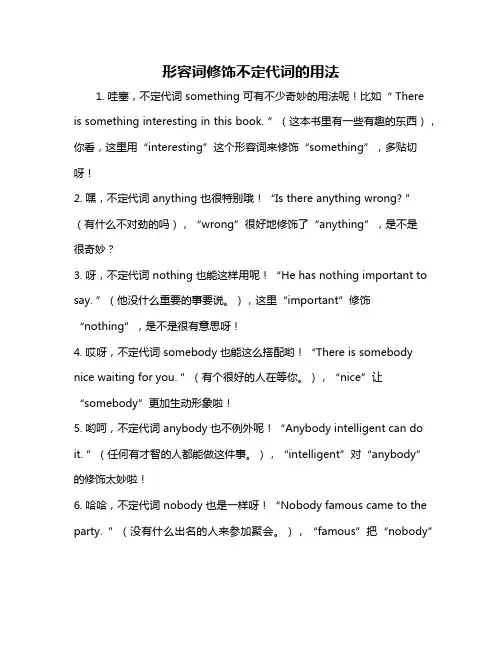
形容词修饰不定代词的用法
1. 哇塞,不定代词 something 可有不少奇妙的用法呢!比如“ There is something interesting in this book. ”(这本书里有一些有趣的东西),你看,这里用“interesting”这个形容词来修饰“something”,多贴切呀!
2. 嘿,不定代词 anything 也很特别哦!“Is there anything wrong? ”(有什么不对劲的吗),“wrong”很好地修饰了“anything”,是不是
很奇妙?
3. 呀,不定代词 nothing 也能这样用呢!“He has nothing important to say. ”(他没什么重要的事要说。
),这里“important”修饰“nothing”,是不是很有意思呀!
4. 哎呀,不定代词 somebody 也能这么搭配哟!“There is somebody nice waiting for you. ”(有个很好的人在等你。
),“nice”让“somebody”更加生动形象啦!
5. 哟呵,不定代词 anybody 也不例外呢!“Anybody intelligent can do it. ”(任何有才智的人都能做这件事。
),“intelligent”对“anybody”的修饰太妙啦!
6. 哈哈,不定代词 nobody 也是一样呀!“Nobody famous came to the party. ”(没有什么出名的人来参加聚会。
),“famous”把“nobody”
描述得好准确呀!总之,形容词修饰不定代词的用法真的超有趣,让我们能更准确地表达意思,大家可要好好掌握呀!。

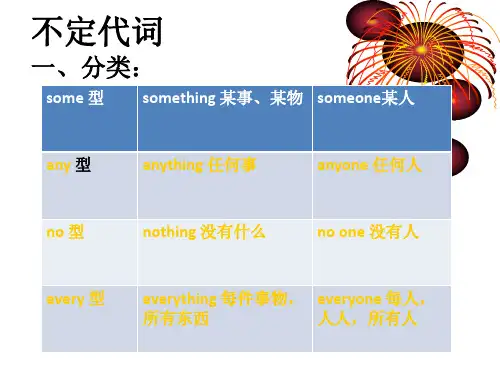

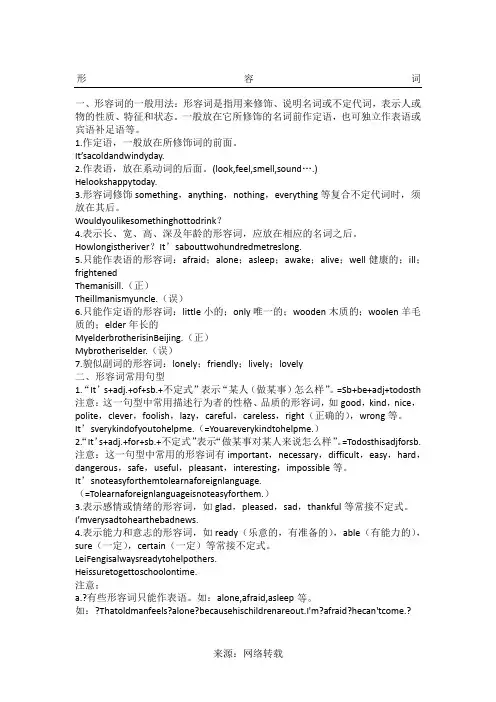
形容词一、形容词的一般用法:形容词是指用来修饰、说明名词或不定代词,表示人或物的性质、特征和状态。
一般放在它所修饰的名词前作定语,也可独立作表语或宾语补足语等。
1.作定语,一般放在所修饰词的前面。
It’sacoldandwindyday.2.作表语,放在系动词的后面。
(look,feel,smell,sound….) Helookshappytoday.I’mverysadtohearthebadnews.4.表示能力和意志的形容词,如ready(乐意的,有准备的),able(有能力的),sure(一定),certain(一定)等常接不定式。
LeiFengisalwaysreadytohelpothers.Heissuretogettoschoolontime.a.?有些形容词只能作表语。
如:alone,afraid,asleep如:?Thatoldmanfeels?alone?becausehischildrenareout.I'm?afraid?hecan'tcome.?b.?形容词与不定代词something,anything,nothing,everything等连用时,要放在这些词后面。
如:?Thereis?something?wrongwithmyDVDmachine.It's?nothing?serious.?c.?某些形容词可以和定冠词连用,表示一类人或事物,其作用相当于一个名词。
如:?theyoung(年轻人),thepoor(穷人),therich(富人)?d.?如果有两个以上的形容词修饰同一个名词时,其前后排列顺序一般如下:限定词(a/the,this/some/her……)+数量词(先序数词后基数词)+观点+大小+形状+新旧+颜色+产地+材料+名词。
如:abigoldGermancomputerⅡ副词DaiYuqiangsings?quite?well.?.副词表示频度修饰动词时,位于连系动词和助动词之后,行为动词之前。
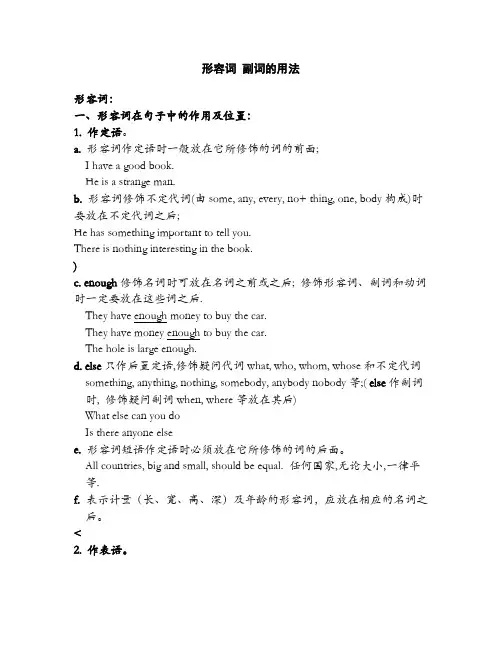
形容词 副词的用法形容词: 一、形容词在句子中的作用及位置: 1. 作定语。
a. 形容词作定语时一般放在它所修饰的词的前面;I have a good book. He is a strange man. b. 形容词修饰不定代词(由 some, any, every, no+ thing, one, body 构成)时 要放在不定代词之后; He has something important to tell you. There is nothing interesting in the book. ) c. enough 修饰名词时可放在名词之前或之后; 修饰形容词、副词和动词 时一定要放在这些词之后. They have enough money to buy the car. They have money enough to buy the car. The hole is large enough. d. else 只作后置定语,修饰疑问代词 what, who, whom, whose 和不定代词 something, anything, nothing, somebody, anybody nobody 等;( else 作副词 时, 修饰疑问副词 when, where 等放在其后) What else can you do Is there anyone else e. 形容词短语作定语时必须放在它所修饰的词的后面。
All countries, big and small, should be equal. 任何国家,无论大小,一律平 等. f. 表示计量(长、宽、高、深)及年龄的形容词,应放在相应的名词之 后。
< 2. 作表语。
在系动词和半系动词 feel(感到),look(看起来),sound(听起来), smell(闻起来),taste(尝起来),become(变成)get(变成),turn (变成),fall(变成), seem(似乎,好象)后,用形容词作表语。
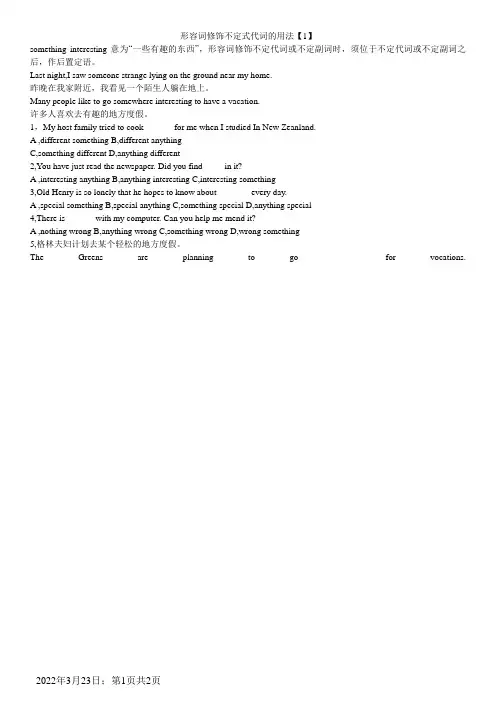
形容词修饰不定式代词的用法【1】something interesting意为“一些有趣的东西”,形容词修饰不定代词或不定副词时,须位于不定代词或不定副词之后,作后置定语。
Last night,I saw someone strange lying on the ground near my home.昨晚在我家附近,我看见一个陌生人躺在地上。
Many people like to go somewhere interesting to have a vacation.许多人喜欢去有趣的地方度假。
1,My host family tried to cook_______for me when I studied In New Zeanland.A ,different something B,different anythingC,something different D,anything different2,You have just read the newspaper. Did you find_____in it?A ,interesting anything B,anything interesting C,interesting something3,Old Henry is so lonely that he hopes to know about________every day.A ,special something B,special anything C,something special D,anything special4,There is_______with my computer. Can you help me mend it?A ,nothing wrong B,anything wrong C,something wrong D,wrong something5,格林夫妇计划去某个轻松的地方度假。


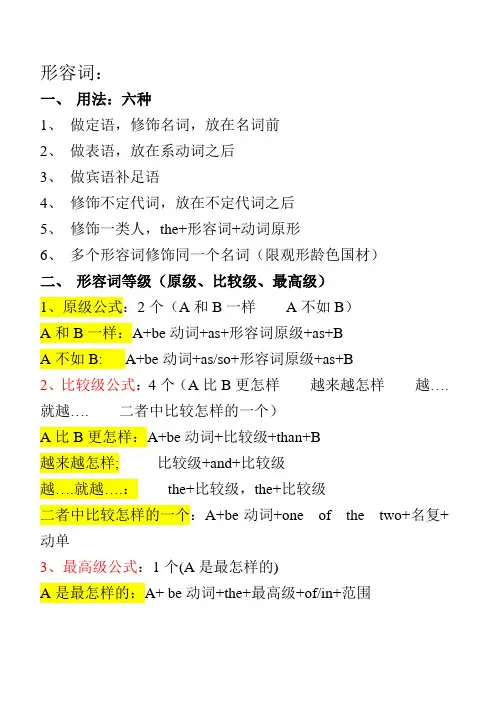
形容词:一、用法:六种1、做定语,修饰名词,放在名词前2、做表语,放在系动词之后3、做宾语补足语4、修饰不定代词,放在不定代词之后5、修饰一类人,the+形容词+动词原形6、多个形容词修饰同一个名词(限观形龄色国材)二、形容词等级(原级、比较级、最高级)1、原级公式:2个(A和B一样A不如B)A和B一样:A+be动词+as+形容词原级+as+BA不如B: A+be动词+as/so+形容词原级+as+B2、比较级公式:4个(A比B更怎样越来越怎样越….就越…. 二者中比较怎样的一个)A比B更怎样:A+be动词+比较级+than+B越来越怎样; 比较级+and+比较级越….就越….:the+比较级,the+比较级二者中比较怎样的一个:A+be动词+one of the two+名复+动单3、最高级公式:1个(A是最怎样的)A是最怎样的:A+ be动词+the+最高级+of/in+范围三、同义句转换:A+ be动词+the+最高级+of/in+范围= A+be动词+比较级+than+any other+名单+范围=A+be动词+比较级+than+the other+可复+范围= A+be动词+比较级+than+anybody/anything+else+范围四、形容词比较级和最高级的变换1、一般情况下,比较级+er 最高级+est2、以e结尾的比较级+r, 最高级+st3、辅音字母+y结尾的,变y为i后,比较级+er最高级+est4、辅音+元音+辅音结尾的,双写末尾的辅音字母后比较级+er最高级+est5、多音节和双音节词,比较级+more 最高级+most6、不规则good/well--better--best bad/badly—worse--worstmany/much—more—most little—less—leastold—older/elder—oldest/eldestfar—farther/further—farthest/furthest。
形容词的基本概念及用法一、形容词的定义:形容词是用来修饰名词或代词的,在句中可用作定语、表语和宾语补足q五坐语等。
二、形容词的用法:⑴ 用作前置定语,即放在名词前修饰该名词。
例如:China is a great country with a long history. 中国是一个历史悠久的国家。
⑵ 用作后置定语。
形容词修饰不定代词或形容词短语修饰名词时,需要后置。
例如:He has something important to tell you. 他有重要的事告诉你。
She is a girl good at singing. 她是一位擅长唱歌的女孩。
⑶ 用作表语。
例如:It was rainy yesterday, but today it is sunny. 昨天下雨,今天天晴。
Your mother seems angry. 你母亲看上去生气了。
The milk in the glass has gone bad. 玻璃杯里的牛奶发臭了。
The leaves turn yellow in autumn. 树叶在秋天变黄。
注意:有一些形容词在句中只能用作表语,我们称之为“表语形容词”。
初中英语中常见的表语形容词有:afraid, alive, alone, asleep, glad, ill (生病的), ready, sorry, sure, unable, well (健康的)等。
例如:I ' m sorry not to have been ready for the party. 很抱歉,晚会我还没有准备好。
The children were asleep ju st now, but now they ' re 孩Wa们e刚才在睡觉,现在醒了。
They were unable to help us. 他们没法帮助我们。
⑷ 用作宾语补足语。
例如:The news made her happy. 那个消息使她很开心。
不定代词不定代词指不明确指代某(些)事或某(些)人的代词。
注意事项:1. 形容词修饰不定代词时,作后置定语Eg. Be quite! I have something important to tell you/2. 不定代词作主语时谓语用单数Eg. Listen! Someone is singing in the next room.I. some 和any1.some表示一些,可以代替名词和形容词,作定语时,既可修饰可数名词也可修饰不可数名词,一般用于肯定的陈述句中。
any表示“一些,任何”,多用于否定句、疑问句或条件句中,可作名词也可作形容词,作定语时,它可以修饰可数名词(多为复数)和不可数名词。
用于否定句中,与not连用的时候,意为“没有一点”.例如:T here isn’t any ink in my pen.我的钢笔没有墨水。
(作定语)Eg. Some are doctors,some are nurses.有些人是医生,有些人是护士。
(作主语)、2. 在疑问句中有时也用some,表示希望得到肯定回答或表示请求、建议、命令等含义。
Eg. Would you please fetch me some water?May I ask you some questions? Certainly. What's it?3. any也可以用在肯定陈述句中,表示“任何的”、“任何一个的”,其后接名词单数形式Eg. You can ask any question you like.You may come at any time;I’ll be home the whole day.你任何时候来都行,我整天都将呆在家里。
Exercise:1. ---- I feel a bit hungry.---- Why don't you have __B__ bread?A. anyB. someC. littleD. aII. both和all1. both用来指两个人或物,表示“两个,两者都”,表肯定,后面接复数名词Eg. My parents are both doctors.both....and... 表示“既...也....,两者都....”both A and B结构做主语时,谓语动词用复数Eg. Both mother and father are teachers.2. all用来指三个或三个以上的全体,表示“三者以上全都”,也表肯定,但它也可代表不可数名词Eg. All of us like her.= We all like her. 我们所有人都喜欢她。
不定代词用法归纳不定代词用法归纳今日给大家带来不定代词用法归纳,我们一起来学习吧,下面我就和大家共享,来观赏一下吧。
不定代词用法归纳不定代词概说英语的不定代词有all, each, both, either, neither, one, none, little, few, many, much, other, another, some, any, no, (a) few, (a) little, both, enough, every 等,以及由some, any, no 和every 构成的合成代词(即somebody, anyone, nothing 等)。
在这些不定代词中,多数都能作主语、宾语、表语或定语,但是代词none 以及由some, any, no 和every 构成的合成代词只能作主语、宾语或表语,不能作定语,而no 和every 则只用作定语。
二,不定代词分三类1,一般不定代词,如:some, any, 及由他们和one,body,thing等组成的复合不定代词someone,anyone,no one;something,anything,nothing;somebody, anybody,nobody,one ,none 。
2个体不定代词,如all,every both each other another either neither half everybody,everyone,everything 3是数量化不定代词,如:many, much, few, little,(a) few, (a) little,a lot of, lots of.三,不定代词既可指人也可指物,但其中由-body和-one构成的复合代词只能指人;而由-ing构成的复合代词以及修饰不行数名词的much (a)little 只能指物。
比如:There is much to do.有许多事情要做。
关于形容词的用法1、形容词的用法形容词是用来说明和修饰名词的性质或特征的词类,分为普通形容词和表语形容词,有原级、比较级和最高级之分。
(1)主要用作定语、表语或补足语。
abeautifulpark一座美丽的公园theplaytea-houseisbothmovingandinteresting。
wholeftthewindowopen?(2)[定冠词the+形容词"表示一类人或物,作[主语或宾语",意思为[……的一种人",[……的一类东西或事情"。
如:thenewwilltaketheplaceoftheold。
新事物将代替旧事物。
theyoungarefondofsports。
年轻人喜欢体育运动。
(3)某些动词加[-ed"和[–ing"都可构成形容词,加-ed的形容词表示[本身是……",加[-ing"的形容词表示[能够引起……",如:thedisappointingboymadehisparentsverydisappointed。
这个令人失望的男孩让让父母很失望。
wewereexcitedwhenweheardtheexcitingnews(4)复合形容词的构成1)形容词+名词+edkind-hearted好心的,white-haired白发的2)形容词+形容词red-hot炽热的,dark-blue深蓝的3)形容词+现在分词good-looking好看的,easy-going随和的4)副词+现在分词hard-working勤劳的,fast-moving快速转动的5)副词+过去分词hard-won得来不易的,newly-made新建的6)名词+形容词life-long终生的,world-famous世界闻名的7)名词+现在分词peace-loving爱好和平的,fun-loving爱开玩笑的8)名词+过去分词snow-covered白雪覆盖的,hand-made手工的9)数词+名词+edfour-storeyed4层楼的,three-legged3条腿的10)数词+名词(名词用单数)ten-year10年的,two-man两人的2、副词的用法副词在句子中主要用作状语,用来修饰动词、形容词和其他副词的词,有时还可修饰介词短语和句子。
由some, any, no, every构成的复合不定代词的用法not anything =nothingnot anybody=nobodynot anyone=no one 例如:There is not anything in this bag.=There's nothing in this bag.这个书包里什么都没有。
He could find nobody to tell his secret.=He couldn't find anybody to tell his secret.他找不到人来分享他的秘密。
①修饰不定代词的定语放在它们的后面。
例如:something new一些新的东西(形容词修饰不定代词)nothing to eat没有可吃的东西(动词不定式修饰不定代词)anybody else其他任何人(副词修饰不定代词)②这些不定代词作主语时,谓语动词用单数。
但在反意疑问句中,当主语是指人的复合代词如somebody, anybody, nobody, everybody等时,其反意疑问句后面的主语通常用they或he;当前面句子中主语是指物的复合代词如something, anything, nothing, everything等时,其反意疑问句后面的主语通常用it 例如:Everything grows fast in spring.春季里万物生长得很快。
Somebody is waiting for you at the teachers' office now.有人正在教师办公室等你。
Everyone has talked about the topic for 5 minutes.关于这个题目,每个人都已谈了五分钟。
Somebody gives us a lot of food to eat, don't they?有人给我们很多食物,不是吗?Nothing is serious, is it?事情不严重,是不是?③anything, anyone, anything用在肯定句中表示“任何人”或“任何事";something用在疑问句中,表示提供某物给别人或希望得到对方肯定的回答。
形容词修饰不定式代词的用法
something interesting意为“一些有趣的东西”,形容词修饰不定代词或不定副词时,须位于不定代词或不定副词之后,作后置定语。
Last night,I saw someone strange lying on the ground near my home.
昨晚在我家附近,我看见一个陌生人躺在地上。
Many people like to go somewhere interesting to have a vacation.
许多人喜欢去有趣的地方度假。
1,My host family tried to cook_______for me when I studied In New Zeanland.
A ,different something B,different anything
C,something different D,anything different
2,You have just read the newspaper. Did you find_____in it?
A ,interesting anything B,anything interesting C,interesting something
3,Old Henry is so lonely that he hopes to know about________every day.
A ,special something B,special anything C,something special D,anything special
4,There is_______with my computer. Can you help me mend it?
A ,nothing wrong B,anything wrong C,something wrong D,wrong something
5,格林夫妇计划去某个轻松的地方度假。
The Greens are planning to go_______ _____for vocations.
答案
1,C,2,B,3,C,4,C,5,somewhere relaxing。